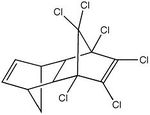Difference between revisions of "Isodrin"
Dronkers J (talk | contribs) |
|||
| (6 intermediate revisions by one other user not shown) | |||
| Line 1: | Line 1: | ||
| − | Isodrin | + | {{ Definition|title=Isodrin |
| − | Isodrin belongs to the group of [[organochlorine pesticides]] | + | |definition= Isodrin belongs to the group of [[organochlorine pesticides]]}} |
| + | == Notes == | ||
| − | + | {| class="toccolours" border="1" style="float: right; clear: right; margin: 0 0 1em 1em; border-collapse: collapse;" | |
| + | ! bgcolor="#FF8888" | Isodrin | ||
| + | |- | ||
| + | | align="center" bgcolor="#FFFFFF" | [[Image:isodin.JPG|150px|isodrin]] | ||
| + | |- | ||
| + | ! bgcolor="#8888FF" | Formula | ||
| + | |- | ||
| + | | align="center" | C<sub>12</sub>H<sub>8</sub>Cl<sub>6</sub> | ||
| + | |- | ||
| + | |} | ||
| − | + | Together with the other "drins", aldrin, dieldrin and endrin, isodrin was developed in the 1940s to provide an alternative to [[DDT]]. European drin production peaked in 1967 and ceased in 1990. It used to be commonly used as an insecticide in agriculture and to control malaria spreading mosquito's. | |
| − | + | Since isodrin is no longer manufactured or used in the European Union or the United States, its leakage to the marine environment from these countries is not expected to be significant. | |
| − | + | In water mostly adsorbs to suspended particles, organic matter, soils and sediments. It has a low tendency to evaporate and isn't easily degraded in the atmosphere, causing it to be transported over great distances. It is also stable in water and soils. It can take between 0,5 and 6 years to half the isodin concentration of a soil. <ref>[http://www.speclab.com/compound/c465736.htm www.speclab.com]</ref> | |
| − | + | ||
| − | + | Isodrin may [[bioaccumulation|bioaccumulate]] in aquatic organisms and has a tendency to [[biomagnification|biomagnify]] through [[food chain|food chains]]. [http://www.environment-agency.gov.uk/business/topics/pollution/39197.aspx UK environment agency] | |
| − | + | ||
| − | + | Isodrin is a very toxic chemical for fresh water fishes. They die when exposed to concentrations above 6 µg/l. Zooplankton and chrustations start dying when exposed to concentrations above 1 mg/l. [http://www.pesticideinfo.org/Detail_Chemical.jsp?Rec_Id=PC38923 www.pesticideinfor.org] | |
| − | + | <P> | |
| − | + | <BR> | |
| − | + | <P> | |
| − | + | == Environmental standards and legislation == | |
| − | + | ||
| − | + | [[OSPAR List of priority substances|Included in the OSPAR list of substances of priority action]] | |
| − | [http://www. | + | |
| + | |||
| + | ==References== | ||
| + | <references/> | ||
| + | |||
| + | {{author | ||
| + | |AuthorID=19826 | ||
| + | |AuthorFullName=Daphnis De Pooter | ||
| + | |AuthorName=Daphnisd}} | ||
| + | |||
| + | [[Category:Toxicity chemicals]] | ||
Latest revision as of 14:19, 9 August 2020
Definition of Isodrin:
Isodrin belongs to the group of organochlorine pesticides
This is the common definition for Isodrin, other definitions can be discussed in the article
|
Notes
| Isodrin |
|---|

|
| Formula |
| C12H8Cl6 |
Together with the other "drins", aldrin, dieldrin and endrin, isodrin was developed in the 1940s to provide an alternative to DDT. European drin production peaked in 1967 and ceased in 1990. It used to be commonly used as an insecticide in agriculture and to control malaria spreading mosquito's. Since isodrin is no longer manufactured or used in the European Union or the United States, its leakage to the marine environment from these countries is not expected to be significant. In water mostly adsorbs to suspended particles, organic matter, soils and sediments. It has a low tendency to evaporate and isn't easily degraded in the atmosphere, causing it to be transported over great distances. It is also stable in water and soils. It can take between 0,5 and 6 years to half the isodin concentration of a soil. [1]
Isodrin may bioaccumulate in aquatic organisms and has a tendency to biomagnify through food chains. UK environment agency
Isodrin is a very toxic chemical for fresh water fishes. They die when exposed to concentrations above 6 µg/l. Zooplankton and chrustations start dying when exposed to concentrations above 1 mg/l. www.pesticideinfor.org
Environmental standards and legislation
Included in the OSPAR list of substances of priority action
References
Please note that others may also have edited the contents of this article.
|